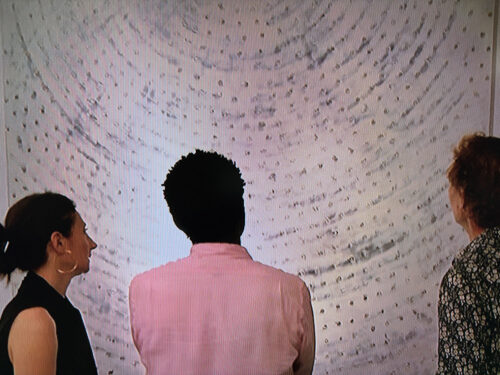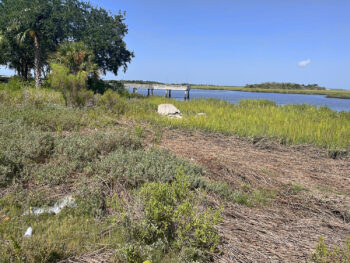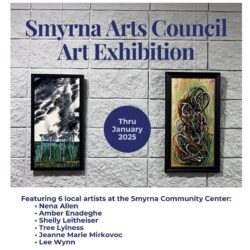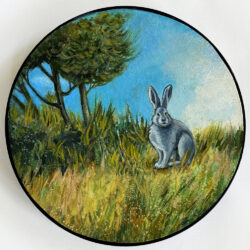“What, in your estimation, is the most overrated thing in the art world?
Hyper-specificity. Esoteric work that speaks only to very small groups of people or that requires an extensive amount of explanation to engage with. More and more I think about the balance between alienating an audience and inviting them in. I don’t think this has to preclude complexity, and I’m not pro-populism. I just hate giving time to something, and then feeling like, “Ok, so what?” That misses the mark for me. Art has to speak for itself.”
– Emma Fernberger, from Artnet
So true!
I really don’t like art that alienates people. One way to alienate potential art lovers is for a gallery to pretend simple ideas in a painting or sculpture are majestic, mind-boggling concepts that need extensive explanation. This can make the viewer feel they need to care deeply but will never really understand the art. Should art be that hard to experience?
Another even more common way is when a gallery will present something like a floating dress on a giant canvas, or a rocky blob, as great gallery-worthy art and slap a huge price tag on it. Should art be that confusing or even offensive?
There are many other examples like these that I see every time I go to a “reputable” well-known or big gallery in a city like Atlanta.
Personally, I think art should be easy to enjoy, easy to understand, relatable to people (before the long explanations and talks) and at least somewhat affordable by regular people in order to be enjoyed by more than a tiny group of people. This is why small galleries are better than the galleries that target wealthy people.
One reason some art gets a reputation for being “elitist” or worse is that it’s not approachable by the average person, or a person is put off by an exorbitant price like many galleries have for very sub-standard work. (In contrast, you will see that all of the art at Fine Art South/Fine Art By Shelly is very affordable by regular people, compared to prices you will see in galleries).
But “art snobbery” is a real perceived thing and I wish more galleries would not make it worse, because it can affect all of us artists. I’m not referring to forms of abstract art, which people may or may not like for any reason, even just colors used. I’m referring to art whose meaning and purpose is so paramount that the actual physical art manifested by the idea is unrelatable, or a bad translation of the idea, or badly done, or so out of reach or comprehension that people are baffled or even insulted by it. I’ll give you an example.
I once saw an exhibit at the MIA in Minneapolis of a series of paintings comprised of small floating letters in no particular groupings or relatable shapes (or any shapes) on a neutral (bland) colored background. To my recollection, the letters were all one vowel – “e”. There may have been others. I can’t remember the artist name, but he made a very, very big deal about this work. There was a deep meaning behind these paintings that I didn’t understand at the time, and I don’t remember anything about it at all, but I heard him speak about it at long length and I was so annoyed with him. Like, what kind of talent or education is required to do this? None. Anyone could have done this. Was he even really an artist? It was ridiculously pretentious, to my mind.
Who wants to look at the manifestation of that idea, whatever it was?

I wonder who bought those paintings, if anyone, and why. Even being an artist myself, I often don’t see the reason behind making art that has to be over-explained and given a great meaning that few can understand. I do believe that most of the time, art should speak for itself. If it doesn’t, and it needs a long explanation, why not just write a book or a poem instead? Why even claim the visual thing is the primary part of the art?
What is the purpose of undecipherable and pretentious art? Yes, I took years of art history in college, I understand all the art movements and realize their validity, and I love and create abstract art myself but I don’t see the point of making or selling 3D real-world art that would be better off remaining as just an idea.
Admittedly I am handicapped when talking to people about my artwork. I can write about it, but it’s hard for me to talk about art, in part because I feel the art itself should be the communication, not the talking about it.
I was at an art fair once where a painting I was displaying was admired by a woman who said, “Oh, that’s very interesting”. It was a painting I no longer have (painted over) of a segment in the woods where a deer had flattened the grass by sleeping there. It was titled, “Where the Deer Lay”. I thought that was pretty self-explanatory. Yet this women looked at me and paused and lingered in a way that told me she really wanted me to tell her a story about this painting. I had nothing to tell her. It was all right there, in front of her. I even thought for a few seconds that she was kind of odd for wanting me to talk about it. I didn’t feel I should explain something so obvious to her, so I just smiled and said thanks. (This was at an art fair, where we artists are expected to mingle and talk with possible buyers, and I just had such a hard time making art chitchat about my own self-explanatory art with people that I no longer do art fairs.)
Keep in mind much of the undecipherable art that exists historically has been done by men, which was probably the only reason it’s taken seriously. But of course not all of it was made by men. One of the most puzzling art exhibits I have ever seen in person was one of rocks sinking into a marsh, down by Brunswick, Georgia. There is a long, deeply meaningful purpose to the rocks. Last summer I photographed this art exhibit, and wow, it is really hard for me, even as an artist, to call this art. The meaning behind it is important, but why didn’t the artist just do a drawing and write a poem or book, instead of sinking rocks in a marsh that literally can’t even be discerned from the normal landscape? It was even hard to find. There is no signage. There is just these rocks. And this was done by a woman artist. In this case, her identity by itself as a black woman is one of the reasons this is considered art. I don’t argue at all with her motives or purpose, but it must be admitted with without a lengthly explanation this is impossible to view as art. So is it really art, or is just the idea of it art?
Lengthy explanations in the form of books have been written about this rock display, but those books were not written by the artist. Also this article, from The NY Times, which was how I first came to know the story about the rocks. The Times refers to it this way: A Vanishing Masterpiece in the Georgia Marshes
This patch of coastal wetland between highway and marsh, just behind downtown Brunswick, Ga., is a kind of pilgrimage site — though no sign points to it.
Look for a small park along U.S. 17, with a pavilion and a pier from which people fish and trap crabs. Across the channel, the Marshes of Glynn stretch flat to the horizon.
But the object of interest — to some art historians and aficionados — sits just outside the park, where the spartina cordgrass takes over. Three rocklike forms nestle in the vegetation. They are weathered and easy to miss.
Here is a major work of American outdoor sculpture, hiding in plain sight. What look from afar like a random trio of rocks are in fact constructions of concrete topped with tabby, a historic material in this region formed from oyster shells, sand and water.
A major work of American scupture no less! I go to the coast of Georgia nearly every summer so I have driven by this many times without knowing what it was. It was only after reading about it that I even knew it was there. If I had known these rocks were there, without the story behind it, I would not have thought it was anything but rocks. The question remains: Is it anything but rocks, without the story? Isn’t the story the art?
This is my own photo of it. The rocks you see in the very center are the “masterpiece”.
Don’t get me wrong, I respect the artist, (now passed away).
The “Marsh Ruins,” as they are called, are arguably the masterwork of the painter and sculptor Beverly Buchanan. She built them in 1981, her own intervention in a charged landscape. The work is partly a homage to Igbo Landing, a fundamental story of Black freedom-seeking that unfolded at the other end of these marshes.
I just think this is a good example of how people can be confounded and baffled by what some artists produce as their art. And I do wonder why people make such a big deal about something like a group of rocks, or some floating letters, or any other example of visual art that needs long explanations. Would it be better to just write about the idea and keep it at that, if the art is primarily the explanation itself?
It may also be time to redefine the descriptive term “masterpiece”.
There is no conclusion being reached by my observations. They are just my observations, and obviously I have a lot of questions about the way the art world works. To me, it’s really broken and inaccessible to too many people.
Kudos to all artists doing all kinds of artwork, even the floating letters that spell out nothing on the beige backgrounds, and even rocks. I do strongly feel that the physical art should – most of the time – be its own story, its own narrator, without books written about it necessary to explain it.
I hope art lovers view all art at Fine Art South and Fine Art By Shelly to be approachable and easy to enjoy. If you have any questions about any of it, send me an email or use the contact form here.






